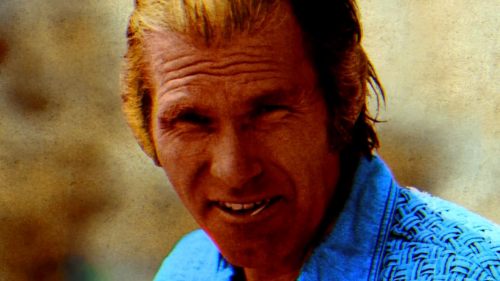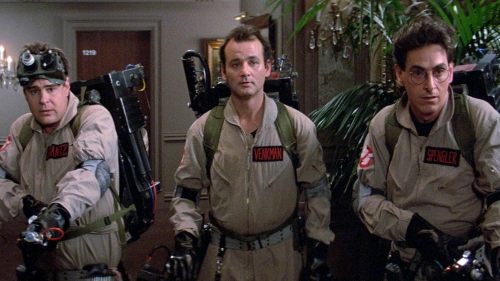Collins’ Crypt: Bad Movies Used To Be So Much Better
I forget what bad movie I was watching at the time, but a while back I realized one of the main things that separated bad horror movies of the '60s and '70s from bad horror movies of today: nowadays, no one on the crew really has to know what they are doing. In the modern world, with even Steven Soderbergh feeling that an iPhone is an acceptable means of shooting a major motion picture, there's nothing to stop dreamers without an ounce of experience or knowledge on making a film from doing it anyway, and if (OK, when) they unsurprisingly get rejected from traditional platforms of release, they can always just put it on YouTube for everyone to see. No matter how inept and amateurish, it'll get out there now.
This was not the case before digital cameras (or even VHS camcorders) were around for anyone to pick up and use with relative ease. Even if the actors were all awful and the script a pile of gibberish, there had to be someone who knew how to load a film camera, someone who knew how to sync sound up to that image (or at least dub it; see: Manos), and someone to cut that physical film on a flatbed because they couldn't just dump it into an AVID and click around until they figured it out. Likewise, while there were always independent release options, the majority of the notoriously bad films we know and "love" were picked up and played theatrically in several regions if not nationwide, building their notoriety to a certain degree. In other words, a film had to have at least a handful of competent people putting them together, allowing them to have the illusion of a "real movie" their modern day counterparts often lack. If they were made as badly as modern stuff, they wouldn't be released, if they even got finished at all.
Such is the case with Invasion of the Blood Farmers, an obscuro recently rescued by the good folks over at Severin Films. Filmed in a reported six days for around $24,000, the film is often on a level with Plan 9 or Manos in terms of its technical merits or lack thereof, but with a better/slightly more coherent story than either of those, thankfully. The "Blood Farmers" are a group of Druids who are seeking a particular blood type in order to resurrect their dormant queen, so they set about randomly killing people in a small upstate New York town until they find someone who has a match. Meanwhile, after a local named Jim Carrey (!) dies in a bar covered in blood, the town's scientist and his assistant try to figure out what happened to him and what is making the plasma behave so strangely (the sample they took keeps growing in size). So in between science gobbledygook and hurried phone calls to other experts, we get a few wacky kill scenes that are in the vein of HGL (albeit with much less splatter) or I Drink Your Blood, giving the film the drive-in spectacle its audience would expect. In other words, scary they aren't, but there's a certain manic energy to them that makes them pop, and offers welcome reprieve from the talkier scenes.

As with a lot of these things, you really have to be in the right mood for them to work their magic on you, and it might help to enjoy your favorite alcoholic beverage and/or controlled substance while it unspools. The acting ranges from atrocious to non-existent, making any dialogue-heavy scene a gutbuster even if the dialogue itself wasn't total nonsense. You can often see the actors reading their lines from something off camera (note the guy who keeps looking at his lap while on the phone) and/or looking directly into the camera as if to say "Are we still on?", and the more people there are in a scene the funnier it usually is. Anything in the bar is just pure gold, as the actors (using the term loosely) often stumble over each others' lines, look off in odd directions when replying, etc.
But the insane plot and general lack of concern about it from most of its characters is what really makes the thing "shine". I particularly liked the subplot of an artifact that the young hero finds, which he plans to give to his fiance as a pendant, and shows it to his scientist boss (her dad) to see if he knows what it is. After knocking it against a table and declaring that it's unlike no other metal on earth, he manages to get it into the hands of the bad guy (another scientist; our guy isn't aware of his colleague's druid ways), who later claims he threw it away - to which the dad just shrugs off and changes the subject. What an asshole! There are a number of odd little things like this, where I can't tell if the script was just that silly or if the "actors" just weren't selling anything they were supposed to be emoting, but I don't care either - it's what makes the movie more than just an ordinary bad movie.
Which brings me back to what I was saying earlier - as inept as everything on-screen often was, there were people on the crew who knew what they were doing, and I think that's the secret formula for what separates this from the sort of insufferable crap we see today. Thanks to over a decade of writing about horror, I am on a number of screener lists no one would be jealous of, and while most of the publicists push me to watch doesn't sound interesting enough for me to bother with, every now and then I take a chance (usually because it sounds like a slasher or an evil child movie, where I know I'll be more forgiving). Without naming names, there's one I saw recently that was supposed to take place in a sorority house but was clearly filmed in a Hollywood apartment with a couple bedrooms, and the low budget probably being eaten up by securing a "Scream Queen" of minor infamy to play a bit part. The acting and writing was just bad as Blood Farmers, but while I had fun with that I damn near hated this, even though as a slasher it was right in my wheelhouse - how else can you explain the difference?

I truly think the editing plays a big part of it, especially as I see so many modern films being edited by their directors; while it's not always the case, I know for a fact sometimes this double duty is the result of not having the money to pay for a real editor and having to do it themselves, even if they're not trained in the art. Unlike film vs. digital, I'm not pro "the old way" at all when it comes to editing; having used a flatbed to cut a short film back in college, I would never want to cut an entire feature that way, much preferring the ease and flexibility of an AVID or Final Cut. But the extra work has a payoff - editing on film forced you to be careful and really get in there with your footage, whereas there's a lot of "safety" in cutting on a computer that can keep you at a bit of a distance. Add in the main perk of digital photography ("Shoot for hours, let the actors have fun with it! We have plenty of drive space!") and that's why you get meandering scenes of the "actors" improvising, endless master shots, and a lot of flab since the editor got hired merely because they happened to have Adobe Premiere and watched a few YouTube videos on how to use it.
Michael Findlay, on the other hand, was a veteran of several films before taking the Blood Farmers gig, and while your opinion of his actual talent will vary, you can't deny he at least knew what he was doing. Despite having minimal options due (Farmers' director Ed Adlum says he never shot a second take unless absolutely necessary), he gave the film as much energy as anyone possibly could, and - again - on a Moviola editing machine, where you are literally cutting film strips and splicing them together (and then syncing sound along with it), without the comfort of saving multiple timelines or an "undo" option. Even with the occasional continuity error or laughable day for night material (people saying "good night" with the sun high in the sky is always funny), Findlay did a fine job with what he had to work with, and is probably a big part of why people have been asking about a remastered version of this particular title. It may not BE a competent motion picture, but it certainly FEELS like one more often than not, and that's what makes it far more fun to watch than those things I now often scroll past on Netflix or Amazon Prime.
Or maybe it's just funny to watch a bunch of druids burn to death during a failed ritual, I dunno. Whatever the reason is, I just want to thank Severin for giving these movies their due (and hope that they can do the same for this team's next effort: Shriek of the Mutilated). I know it's the more high profile releases (The Changeling, the Amicus stuff) that keep the lights on over there, but these are the titles I get really excited about (they also rescued a particular evil child movie from Canada I'm quite fond of). Not only is it nice to know that these old cheapos aren't going to be confined to budget pack purgatory forever, but it's a great reminder that the bad movies used to be so much better, thanks to the one or two people on crew who absolutely had to know what they were doing because a bunch of 1s and 0s weren't going to be able to cover for them.



